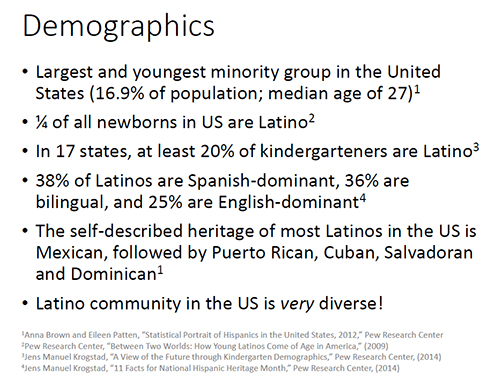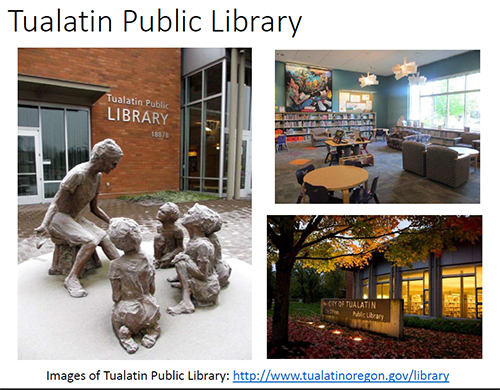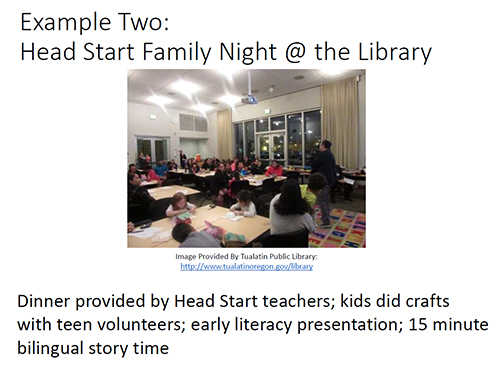Before Bilingual Storytime: Strategies for Successful Outreach to Latino and Spanish-speaking Communities
Library programs for new audiences often suffer from "if we build it, they will come" syndrome. So, if we know simply offering a new program to a new audience isn't likely to be as successful as we want, then what are strategies to ensure better attendance at the programs and to build relationships with patrons new to the library?
That's the question Katie Scherrer, consultant and co-author of Once Upon a Cuento: Bilingual Storytime in English and Spanish, and Lauren Simon, Community Librarian at Tualatin Public Library, sought to answer in the recent webinar Before Bilingual Storytime: The Outreach Bridge to Engaging Latino and Spanish-speaking Families.
Scherrer and Simon presented strategies for engagement with Latino and Spanish-speaking communities, in particular, showed real-world examples of successful connection with these varied communities, and laid out a basic outreach process that you can adapt for you your own community.
 Scherrer began with national demographic information on the Latino population (at right). "The big takeaway from this quick glance is that this community is large, young, growing and very, very diverse," she says. "People often talk about Latinos or Hispanics as though they are one unified group, and the actuality is the Latino community is every bit as diverse as the U.S. as a whole."
Scherrer began with national demographic information on the Latino population (at right). "The big takeaway from this quick glance is that this community is large, young, growing and very, very diverse," she says. "People often talk about Latinos or Hispanics as though they are one unified group, and the actuality is the Latino community is every bit as diverse as the U.S. as a whole."
Throughout the webinar, both presenters make it clear that every community is unique, and learning who the Latinos and Spanish-speakers are in your community and building relationships with those individuals is critical. Stepping outside your library may push your working style and it may take some lobbying within your library to get the o.k. Make the case to yourself or your colleagues about the importance of outreach, which:
Builds awareness
- People's experience with public libraries in their home countries may vary.
- It may be that the library just isn't on people's radar.
Meets people where they are
- If people have concerns or are unaware, the library must be willing to go where the people are to make that connection.
- Explore the barriers in your community (transportation, library hours, etc.).
Helps you learn about what people actually need/want from the library
- Our preconceived notions may not be accurate; need to test this by going out into community.
Builds relationships and establish trust
- Bridge the wariness; give a human face to the library.
 Scherrer then presented excellent, detailed information on how to start your outreach journey from how to investigate the demographics in your area to how to establish a presence outside your library and so much in between. Watch the webinar archive for all the details.
Scherrer then presented excellent, detailed information on how to start your outreach journey from how to investigate the demographics in your area to how to establish a presence outside your library and so much in between. Watch the webinar archive for all the details.
Next, Simon talked about her experience with outreach to the Latino and Spanish-speaking communities in the Portland, OR, metro area at Tualatin Public Library.
Takeaways from Simon include:
- Go to the same events and groups over and over again, more than just once or twice a year. It's important for people to get to know you and recognize you.
- Building relationships and connections takes time and sometimes goes slowly. She's been at Tualatin two years and finally feels like she's getting traction.
- Word of mouth is important. Get a few library users on your side to help talk up the library. "I've found that a personal invitation in a conversation is a great way to invite people to the library," Simon says.
- Sometimes things don't work exactly how you expect, but it is still important to keep trying. Don't give up!
 She went on to offer strategies, places to promote your programs, and gave real examples of programs at Tualatin Public Library. (Just one of the examples at right.)
She went on to offer strategies, places to promote your programs, and gave real examples of programs at Tualatin Public Library. (Just one of the examples at right.)
The webinar presented a rich array of resources (see below for links), and the chat was particularly lively, so when watching, make sure to download the chat transcript for discussion. And don’t forget to download the Learner Guide for this webinar, which includes a plethora of discussion and reflection questions to help you start an action plan for your library.
Archive viewing options:
- View Archive (You will be prompted to login to our free Catalog.)
- View slides (pdf)
- View chat (xls)
- View captions (txt)
Related Resources:
- Learner Guide (doc), use alone or with others to extend your learning
- On WebJunction:
- Pew Research Center - Hispanic Trends
- REFORMA (The National Association to Promote Library and Information Services to Latinos and the Spanish Speaking)
- ¡Colorín Colorado! - Bilingual website for educators and families of English language learners (including A Guide for Engaging ELL Families: Twenty Strategies for School Leaders)
- Books
- ¡Bienvenidos! ¡Welcome! A Handy Resource for Marketing Your Library to Latinos by Susannah Byrd (see excerpts on WebJunction: Outreach and Publicity for Spanish Speakers -forward by Carol Brey-Casiano
and Four Keys to Successful Marketing to Spanish Speakers) - ¡Hola, amigos! A Plan for Latino Outreach by Susana Baumann
- Serving Latino Communities: A How-to-Do-It Maunual for Librarians by Camila Alire and Jacqueline Ayala
- ¡Bienvenidos! ¡Welcome! A Handy Resource for Marketing Your Library to Latinos by Susannah Byrd (see excerpts on WebJunction: Outreach and Publicity for Spanish Speakers -forward by Carol Brey-Casiano
- Jumpstart Your Outreach Plan OLA 2016 Conference Session Materials
- Connected Communities
